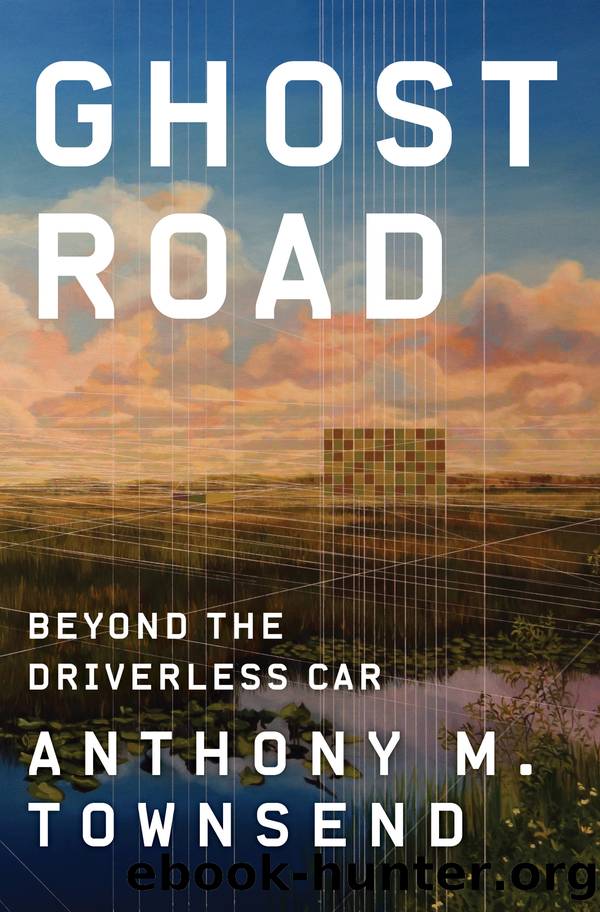Ghost Road by Anthony M. Townsend

Author:Anthony M. Townsend
Language: eng
Format: epub
Publisher: W. W. Norton & Company
Published: 2020-04-29T00:00:00+00:00
The Metered Mile
If the age of free roads is coming to an end, the idea that may finally spell its doom is a scheme known as congestion pricing. By charging people more to travel when and where traffic is heaviest, the thinking goes, people will switch to mass transit, shift their schedules, or take different routes. It’s the darling of think tanks, an idea opposed only by self-serving motorists. But it will also be a catalyst for mobility’s financialization.
As legend has it, Columbia University economist William Vickrey, the father of congestion pricing, was so “uninterested in material comfort that he barely knew how much he was paid.” The absentminded professor was well aware of money’s motivating power, however—auctions were his primary scholarly interest. Vickrey’s pioneering work on the subject earned him a Nobel Prize in 1996. But the polymath was also keenly interested in using market economics to improve the way we allocate public resources. Early in his career, New York City would present him with an ideal opportunity to test his ideas.
It was a fitting, yet ironic, match of man, market, and metropolis. Capitalism had created the great industrial city and, by 1951, was in the process of hollowing it out. The subway system was in rapid decline as the city’s population steadily drained into newly built suburbs. Ridership and revenue had peaked, and the transit authority’s financial outlook was grim. The previous year, a police-corruption scandal had forced the resignation of Mayor William O’Dwyer. In an effort to restore public trust, his successor, Vincent Impellitteri, ordered a sweeping review of the city’s finances. Vickrey was chosen to lead the assessment of transit fares and to try to find a way to stabilize the system.
The rambling study Vickrey produced for City Hall spans more than 150 pages, and makes for dry reading. But it reveals the conceptual roots of congestion pricing as it is practiced today. Vickrey understood the problem foremost as an exercise in marginal-cost pricing, where the price of goods and services is set at the additional cost involved in providing them, rather than at what the market will bear. Fixed costs like track and trains are ignored. In business, marginal-cost pricing often serves as the basis for deep discounting during periods of slow sales—allowing a producer to set the lowest price possible while maintaining output and avoiding operating losses. For the New York City public-transit system, Vickrey reasoned, marginal cost was a perfect measure of what riders would be willing to pay to avoid the delays and discomfort of congestion.
Following this insight, the bulk of the 1951 report documents Vickrey’s painstaking calculation of the spending necessary to relieve rush-hour jams—costs such as adding trains and expanding stations, which grow at an increasing rate as crowding gets worse and worse. The final tally, a detailed matrix of the marginal costs for travel between various zones at different times, was stunning. Vickrey demonstrated that to fairly reflect the marginal costs of rush-hour service into Manhattan’s central business district, fares should be 25 cents—five times higher than the prevailing flat fare of the day (Table 7-1).
Download
This site does not store any files on its server. We only index and link to content provided by other sites. Please contact the content providers to delete copyright contents if any and email us, we'll remove relevant links or contents immediately.
Whiskies Galore by Ian Buxton(40542)
Introduction to Aircraft Design (Cambridge Aerospace Series) by John P. Fielding(32352)
Small Unmanned Fixed-wing Aircraft Design by Andrew J. Keane Andras Sobester James P. Scanlan & András Sóbester & James P. Scanlan(32150)
Craft Beer for the Homebrewer by Michael Agnew(17464)
Turbulence by E. J. Noyes(7061)
The Complete Stick Figure Physics Tutorials by Allen Sarah(6650)
Kaplan MCAT General Chemistry Review by Kaplan(6073)
The Thirst by Nesbo Jo(5802)
Bad Blood by John Carreyrou(5785)
Learning SQL by Alan Beaulieu(5430)
Weapons of Math Destruction by Cathy O'Neil(5055)
Man-made Catastrophes and Risk Information Concealment by Dmitry Chernov & Didier Sornette(4753)
iGen by Jean M. Twenge(4708)
Digital Minimalism by Cal Newport;(4582)
Life 3.0: Being Human in the Age of Artificial Intelligence by Tegmark Max(4525)
Audition by Ryu Murakami(4112)
Electronic Devices & Circuits by Jacob Millman & Christos C. Halkias(4054)
1,001 ASVAB Practice Questions For Dummies by Powers Rod(4050)
Pale Blue Dot by Carl Sagan(4021)
